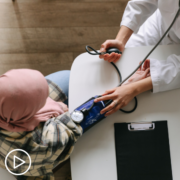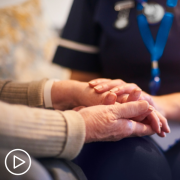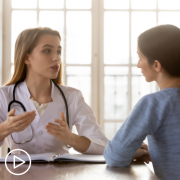Living With an MPN and Being Your Own Best Advocate
Living With an MPN and Being Your Own Best Advocate from Patient Empowerment Network on Vimeo.
MPN patient Rita experienced an extended path to her diagnosis. Watch as she shares her patient journey of varied symptoms, how self-advocacy and self-education assisted in her care, and her tips on how to empower yourself as a patient. In Rita’s words, “Don’t feel bad about advocating for yourself. Your doctor has many patients, but you have only one you.”
Related Resources:

|

|

|
Transcript:
My name is Rita, and I was diagnosed with polycythemia vera in March 2019 after nearly three years of wide-ranging symptoms. Like many patients, my path to diagnosis was long and required me to self-advocate.
I was generally healthy until my symptoms of polycythemia vera began. I first experienced one episode of neck, jaw and chest discomfort, and the hospital blood test showed somewhat elevated platelets, and elevated red cell distribution width (RDW); but the doctors weren’t concerned. Next, I started getting optical migraines that were also dismissed. These were followed by incidents of feeling weak and sweaty; some days with headaches, dizziness, and fatigue; and also looking like I had a sunburn on my face with bloodshot eyes. I dismissed these symptoms. Then I started feeling short of breath at times, especially lying down, and experienced intermittent stabbing underneath my left lower chest area.
After having blood tests done, I had to call to find out my results that showed high hemoglobin, high red blood cells, and high hematocrit levels. After I Googled my test results, the first thing that came up was polycythemia vera. Experiencing additional vision issues, abnormal blood test results, chest pressure, and “foggy headedness” that frightened me, my doctor finally referred me to a hematologist who confirmed my suspicions with a PV diagnosis.
Some things I have learned during my MPN journey include:
- We need to feel comfortable advocating for ourselves, and we need to make sure our doctors are open to being our partner in healthcare rather than our ‘boss’ in health care.
- We also need to educate doctors that what looks like “dehydration” on a CBC could actually be a rare blood cancer.
- Get copies of your own blood test results, X-rays, other medical reports, etc., and, within reason, try to learn what they mean.
- Diagnosed patients should be allowed to self-refer to an MPN specialist rather than be dependent on their physicians to do it.
- We need to self-advocate as “women of a certain age” to make sure we’re not medically or symptomatically reduced to “it’s menopause.”
- Be careful how you express yourself to your doctor, because a careless comment may throw off your path to a correct diagnosis.
- Don’t feel bad about advocating for yourself. Your doctor has many patients, but you have only one you.
These actions are key to staying on your path to empowerment.
My Polycythemia Vera Journey to Empowerment
My Polycythemia Vera Journey to Empowerment from Patient Empowerment Network on Vimeo.
Myeloproliferative neoplasm patient Mark shares his journey to patient empowerment. Watch as he discusses symptoms that eventually pieced together his polycythemia vera diagnosis, helpful support resources, activities that have aided him during treatment, and his advice to help other patients.
See More from Best MPN Care No Matter Where You Live
Related Resources:

|

|

|
Transcript:
Mark:
My name is Mark, and I live in the UK. I was diagnosed with polycythemia vera (PV) in April 2021 after a long path to diagnosis that was complicated by COVID-19 restrictions.
In December 2020, I had a routine blood test that flagged elevated hematocrit. My doctor told me the laboratory would re-do the test after Christmas and not to worry. Meanwhile, I researched various causes of elevated hematocrit and began drinking (approximately) 4 liters of water per day just to rule out any dehydration.
I had the repeat blood test in January 2021, which showed elevated hematocrit again. Next, I was sent for a JAK2 test and referred to a hematologist. I was also switching roles at work and moving at the same time. The moving and medical care changes were worsened by UK-wide COVID-19 restrictions.
I got moved and awaited the results. A month passed with no news, and I could only connect with my medical team by Internet or phone. The test results could take up to 8 weeks. Then I started experiencing some strange eye issue with blurry zig-zag shapes and itching around my ankles and general skin discomfort after showering. I also had a gray-out in one eye that was like a shutter closing over my eye for about 30 seconds. I read about elevated hematocrit and microcirculatory issues before and decided to ignore it until my appointment.
I was still awaiting my test results in March with a consultant appointment booked for April, and my doctor decided to repeat the JAK2 test. The results came in, and I was finally diagnosed with polycythemia vera. I was simply told that I would receive phlebotomies and was given a pamphlet. I went for my initial phlebotomy, and my journey began. Around that time, I told my doctor about the vision issues. They immediately referred me to the TIA clinic to investigate mini strokes and started me on aspirin. I had no signs of a TIA, but the symptoms could not rule out the possibility. Fortunately, the vision issues stopped after my second phlebotomy.
I found the MPNVoice website and began learning about MPNs, which proved invaluable and helped me grasp my situation. It was so helpful to find others who lived with MPNs well beyond the Google-searched life expectancy, and reading their stories gave me comfort. Physically, I noticed that I had slowed down and was feeling sorry for myself, which isolation from COVID-19 restrictions didn’t help. I decided to start volunteering, re-started some yoga, and started exercising. I experienced immediate benefits and find keeping active is now a must.
Initially, my hematocrit level didn’t lower, and I received advice for my hematologist to be more aggressive with my blood draws. With sometimes weekly draws, my levels started dropping. It took 6 months to level out to my target hematocrit maximum.
Upon reflection, some things that I’ve learned during my PV journey include:
- Try not to panic about what you don’t know and can’t control – this allows you to focus on the important stuff.
- During the testing and diagnosis stage, try not to search too much on Google – it’s not helpful!
- Finding others who are in the same situation can make a rare illness less rare and far less scary.
- Keep active and don’t overthink everything. If you start feeling sorry for yourself, do something about it.
These actions are key for staying on your path to empowerment.
How Can MPN Patients Become More Proactive in Their Care?
How Can MPN Patients Become More Proactive in Their Care? from Patient Empowerment Network on Vimeo.
How can MPN patients become more empowered and active in their care? Dr. Claire Harrison from Guy’s and St. Thomas’ Hospital in London shares advice for patients to gain confidence to become a more active participant for optimal care.
See More from Best MPN Care No Matter Where You Live
Related Resources:

|

|

|
Transcript:
Dr. Nicole Rochester:
So what advice would you give for patients so that they can really take a proactive approach to their healthcare and feel more confident in talking about their concerns and communicating with their healthcare team, you’ve shared with us how important that is. Do you have maybe two or three specific tips or maybe questions that every MPN patient should ask their healthcare provider?
Dr. Claire Harrison:
I think the first thing to say is, in my personal view is you do not have to be under an MPN expert to get the best care. I know some people differ with regard to that, but these are chronic conditions, there are national and international guidelines, clinicians are connected. We all talk about patients over time, as we like to do that, we like to get the best for our patients, so a local center with a clinician who you trust, who you get on with…where you can get there easily. You trust their team, you know their logistics work for you, maybe it’s a nurse who work who you get on with, well, who comes to the appointment with you, that is just as good as being under the best professor in the state, where you might not actually see them when you turn up and go to the unit, so that’s really important, understanding your condition, and if you don’t understand being empowered to ask questions, and if you’re in a position where you can’t ask a question, something’s wrong. So don’t be afraid, take somebody with you, write it down.
Sometimes it can be a mistake to do a troll on the Internet, so I wouldn’t always encourage that because what’s on the Internet is not always accurate, but go to a trusted website as the clinician…where can I go to find out more information? Some patient advocacy groups run buddy systems that can also be very helpful and it can be very empowering to meet another patient with the same or similar condition, so I think those are all helpful tips from my perspective, also don’t expect to get all the answers all the time, it can be really tricky as a clinician, maybe you get a patient who comes with a big long list of questions, and say What is your top question that you really want answers to.
Dr. Nicole Rochester:
Those are awesome, awesome tips. I’m just going to repeat a few of them, just to highlight, you mentioned prioritizing your concerns which is incredibly important, and acknowledging that the clinician doesn’t have unlimited time, and so really focusing on the things that concern you the most, you mentioned bringing a buddy to appointments, which is something I fully endorse, so that there’s someone else that’s taking notes or…it can be your eyes and ears during that appointment, things that you may have missed either because of anxiety or stress, and you mentioned writing things down, taking notes, even as the patient asking questions, which is so incredibly important, and really the way that I feel patients demonstrate their involvement in their disease and being an active member of the team, so I really, really appreciate those tips, Dr. Harrison, I think that you have given us so information, so much information about how to empower MPN patients and their families so that they can really get the best care at the outset.
Advice for Hesitant MPN Clinical Trial Participants
Advice for Hesitant MPN Clinical Trial Participants from Patient Empowerment Network on Vimeo.
What should MPN patients know about clinical trials? Dr. Claire Harrison from Guy’s and St. Thomas’ Hospital in London shares information about the varying degrees of clinical trials and advice to those who are hesitant about clinical trials.
See More from Best MPN Care No Matter Where You Live
Related Resources:

|

|

|
Transcript:
Dr. Nicole Rochester:
It’s said that clinical trials are tomorrow’s medicine today, and you’ve already kind of alluded to the importance of clinical trials as it relates to MPN. What would you say to an MPN patient who is on the fence or may be concerned or afraid of participating in a clinical trial?
Dr. Claire Harrison:
It’s right to be cautious and, you know, careful because ultimately it’s a huge privilege as a clinician that involves patients in clinical trials that my patients trust me and trust my team to look after them with something that is experimental, but remember there are varying degrees of experimental. Most clinical trials are not first in man, you’re not a complete guinea pig, it may be a drug, for example, navitoclax is in clinical trials mainly for myelofibrosis also ET and PV but that is a drug that has been used for thousands of patients, for another indication so talk to your healthcare team, if you don’t find the answer from the primary person that you’re used to dealing with, find someone else, be linked to somebody you trust and that you have a good relationship with, take someone with you to the consultation, write down the questions I’m so sure you say this all the time, don’t you Nicole to the people that you talk to, but write down your questions, don’t be afraid to ask them again, there is no stupid question in this context, you will be given a 30-plus page booklet to read, and I lost count of the number of times, my patients go, yeah, I’ve got this, or I trust you.
Actually, you know, you need to read it…we are experimenting on you, and you need to read that and understand. And you need to understand, what happens if I go on the control arm, will I be able to cross over? How many visits will I have, will I have to pay for those visits, etcetera. It’s all really important. But ultimately the relationship with your healthcare provider is important, and using an advocate is really important too.
Dr. Nicole Rochester:
I agree 100 percent. So important, these are things that I talk about all the time, so I really appreciate that you highlighted that, and just the importance of patients taking an active role in their medical care and also the trust that is required between the patient and their treating providers. So I really appreciate that. Do you have any examples, Dr. Harrison, in your own practice of successes with MPN patients who have participated in clinical trials?
Dr. Claire Harrison:
Oh yes, I think I started doing clinical trials, well golly, a long time ago. I think my first clinical trial, probably the records were written parchment to be honest, but we’ve still learned a lot from that, so that was an ET study. It was from that study we understood about the JAK2 mutation, and we understood how patients behave differently. I think probably the most gratifying thing for me was being involved in the JAK inhibitor studies in myelofibrosis and being involved in delivering ruxolitinib and Jakafi to patients and seeing the benefits for those patients.
Big things, you know, there are patients who are alive because they took part in that trial today, I think, but there are also patients for whom small things were also really important, so as a patient, that’s important to define what is the benefit you want to get. So one of my first patients, you haven’t been able to have a bath or a shower for years, because he had terrible what we call aquagenic pruritus, itching induced by contact with water, we called him two days after he started ruxolitinib (Jakafi), and he was in tears, he could take…or you can take it out.
These things are really important. Like myself, I can imagine not being able to dig it out, I would either be very tough for another patient, it was, well, I looked really skinny because I’d lost loads of weight and I put weight on, and body image was really important as well, but then the small things like being able to be…participate more in family activities is really, really important too.
What Are the Unmet Needs in Access to MPN Care?
What Are the Unmet Needs in Access to MPN Care? from Patient Empowerment Network on Vimeo.
Which areas of MPN care still need improvements to access? MPN expert Dr. Claire Harrison from Guy’s and St. Thomas’ Hospital in London explains patients who still experience barriers to care and what can be done to reduce access issues.
See More from Best MPN Care No Matter Where You Live
Related Resources:

|

|

|
Transcript:
Dr. Nicole Rochester:
What would you say are the unmet needs in access related to MPN and care, specifically as it relates to clinical trials, and what can we do to address those unmet needs?
Dr. Claire Harrison:
Well, I think there is a problem with rare diseases in terms of geographical access to trials, and we often find patients have to travel a long way. I know that’s true in North America as well as in Europe. And we’re very lucky in our geographical locations, but in some parts of the world, some companies or doing not open clinical trials, so I think there’s an access issue.
I think also there is something about patients have to meet rigid entry criteria for clinical trials, and so oftentimes in myelofibrosis, for example, commonly patients who fail ruxolitinib (Jakafi) have a lower platelet count, and that is often an exclusion criteria. Those criteria are there to try to get a uniform population of patients in a trial, but it can feel like you’re excluded as a patient, and it can feel very tough and for your health care team that we can’t include you in a clinical trial. We also have to remember that it is there for safety purposes, so if there is a lower limit for platelet count, that’s often because the drug might affect platelet count. It is really important that we have a broad spectrum of trials available and that we try to increase the availability of trials for patients.
I also want to say a word about inequality of access and thinking about accessing some different ethnicity, so often non-white MPN patients are under-represented in clinical trials, and I know that a focus in the UK and also in North America as well. And it is really important that patients have access to a clinical trial if they need it, and also that we understand how investigational products will work in people of different backgrounds. So for example, we know that probably, Nicole, your blood count assuming it’s a healthy, normal blood count may well be different from mine for background, racial genetic differences, so drug metabolism might be different, so this is really important, and we need to work hard as a community, the clinical community and the patient community to raise awareness and improve access for patients.
Dr. Nicole Rochester:
Well, as someone who does a lot of work in health equity, Dr. Harrison, I really appreciate you pointing that out. It’s certainly an issue here in the United States, as you mentioned, differential access to clinical trials, and we’ve learned that not only our patients, often not aware, but often the providers, at least here in the U.S., are not offering clinical trials as an option for patients from marginalized and minoritized communities. So I really appreciate you bringing that up.
MPN Treatment Strategies for Patients Who Have Failed Traditional Therapies
MPN Treatment Strategies for Patients Who Have Failed Traditional Therapies from Patient Empowerment Network on Vimeo.
What can be done for MPN patients who have failed on traditional therapies? MPN expert Dr. Claire Harrison from Guy’s and St. Thomas’ Hospital in London explains some treatments under study as options for some patients.
See More from Best MPN Care No Matter Where You Live
Related Resources:

|

|

|
Transcript:
Dr. Nicole Rochester:
What about for patients who have failed therapies, are there any treatment strategies for MPN patients who have failed traditional therapies?
Dr. Claire Harrison:
Yes, in fact, actually, that’s where we’re evaluating new therapies across all of these entities, so if you’re a PV or an ET patient and you failed a therapy, then this is where, for example, in ET, we would be looking at bomedemstat or we’re looking at the bromodomain inhibitor pelabresib, and there’ll be other agents that we’ll be looking at, or we might be looking at vaccination. And for MF patients that while there are a bunch of different therapies for patients who you have not tolerated or progressed through standard therapy. So actually, there are a lot of options, some of them are already approved, and some of them are in clinical trials.
How Are MPN Treatments Changing for Low-Risk vs High-Risk Patients?
How Are MPN Treatments Changing for Low-Risk vs High-Risk Patients? from Patient Empowerment Network on Vimeo.
How do MPN treatments vary for low-risk and high-risk patients? MPN expert Dr. Claire Harrison from Guy’s and St. Thomas’ Hospital in London explains how treatment differs for these patients and changes that she would like to see for care of some patients.
See More from Best MPN Care No Matter Where You Live
Related Resources:

|

|

|
Transcript:
Dr. Nicole Rochester:
How are treatment strategies changing for low-risk and high-risk patients with MPN?
Dr. Claire Harrison:
It’s complicated because we need to think across the entities, and we don’t have an answer to that for patients with MPN unclassified. And we don’t actually have a good answer to that for this entity called pre-fibrotic myelofibrosis, which does appear and is strongly recognized in the new diagnostic criteria. But for ET, for example, low-risk patients I mentioned triple-negative, calreticulin, M-positive, young patients, platelets less than 1500, not too much changing their queries about aspirin or not, and then for PV patients, we haven’t really changed all kind of high-risk criteria and for both ET and PV, the questionnaire is, should we use the treatment above aspirin or above aspirin and venesection.
And for the most part, that would be hydroxycarbamide, hydroxyurea (Hydrea), which is the commonest treatment used worldwide or interferon, and these are the right treatment for some patients and not the right treatment for other patients, so some patients can be very fixated on interferon is the absolute best, but there is no clear evidence of that, and there are some patients who interferon is not the right treatment, but low versus high risk becomes even more important for myelofibrosis patients.
And here, we’re thinking about using a risky strategy like transplantation for those patients who have higher risk disease, and we’re using, as I mentioned to you, these molecular markers and newer prognostic tools to stratify patients. And it is important to remember as a patient if someone puts your data into a prognostic tool and that comes up with five years, but it doesn’t mean to say five years on the dot your time’s up, that’s an average. And if we put your data into a slightly different tool, we might get something else. So for the most part, we make decisions like transplants, we are learning more about transplantation and outcomes from that, and then in some countries, some treatments are used for patients who fall into intermediate or high-risk categories, and some clinical trials are based on that as well. I would want to say about myelofibrosis, and something I think I would really like to see changed, not changing yet, but changed, is that we should be able to intervene for patients with a low-risk disease. If my myelofibrosis patients have breast cancer, we would not be going there, then you’ve got low-risk disease, we’ll put you on watch and wait, watch and wait is really hard for our patients, we know that I can see you nodding.
You know that too, right? So if these were patients with breast cancer we would not say, we’ll just watch and wait. So I would really like to see in the next five to 10 years a treatment that we could use earlier in the disease course, but there is nothing at the moment, but we’re looking at that. The other thing we’re looking at, if we’ve got a minute or so is the different endpoint, so we’re trying to understand what does it mean if your allele burden, so the amount of abnormal genes you’ve got goes down, the amount of bone marrow fibrosis you’ve got goes down. And again, this is something we’ll collect in a clinical trial, but also from real-world data.
How Can MPN Patients Stay Up to Date With New Treatments?
How Can MPN Patients Stay Up to Date With New Treatments? from Patient Empowerment Network on Vimeo.
What are some ways for MPN patients to stay updated on new treatments? MPN expert Dr. Claire Harrison from Guy’s and St. Thomas’ Hospital in London shares resources for MPN treatment news and the benefits that data sharing brings for all MPN patients.
See More from Best MPN Care No Matter Where You Live
Related Resources:

|

|

|
Transcript:
Dr. Nicole Rochester:
Dr. Harrison, how can patients best keep up with the new treatments and communicate with their doctors in a way that makes sure that they have access to these new therapies?
Dr. Claire Harrison:
Well, I think patient advocacy groups are really important here, and use of social media and the Internet, you’re only a few clicks away from updated data, programs like these, but you also have to trust your team and trust your doctor. We all have to keep up to date. That is a professional requirement, and we also are all networked, so I’d probably get 10 to 15 emails a day from colleague saying, “Hi Claire, can I talk to you about this?” There was an email just the other day about a patient in Washington, actually a very young child, we are all connected.
We all want the best for our patients. But do you remember that you can contribute as a patient to advance this in your field, and I know many patients are really interested in this, if you are asked to submit in a blood sample, giving permission for us to use your data. So if we can touch maybe on the field of real-world data and real-world data collection here would be good, so what on the real world data? What does that mean? And so this is becoming a really important way that’s recognized by the FDA and other approval agencies in the world, so in Europe, we have EMEA, for example, and in the UK, we have NHRA as a way of collecting data on agents, so once they are approved, we collect data with regard to how the patients do.
We’ve traditionally done this, but increasingly, as we use electronic data for our patients, we’re more able to collect real-world data, how does my patient who is with myelofibrosis on ruxolitinib (Jakafi) in my clinic inside East London do? So if we can pull that data, we learn a lot more about how these agents are working in patients outside of clinical trial, so you will be contributing if you allow us to collect that kind of data, we discovered JAK2 mutations, CALR mutations, etcetera from samples collected from patients and data. If you want to be part of a clinical trial, then by all means, ask your healthcare team, many MPN centers have lists of trials, and you can always look at clinicaltrials.gov, but boy you throw up a lot of different options when you search in that…on that website.
Dr. Nicole Rochester:
Thank you. I think it’s important to talk about real-world data because in this day and age, many of us are very protective about our personal health information and we should be, but as you stated, having access to that data is really a key way to advance the science and technology in the treatment of some of these conditions, so I really appreciate you sharing that.
Dr. Claire Harrison:
I think just to point out, and I’m sure the audience is acutely aware of what did we learn about COVID? We learned an awful lot about COVID from real-world data from all you MPN patients who gave samples, who told us about how you did with COVID, that’s how we learned about what happened to patients during COVID with MPN, how they responded to vaccination, etcetera. It’s really powerful. And your data will be anonymized, it won’t be linked back to you, Nicole Rochester, or me, Claire Harrison it will be completely anonymous.
What Is in the Treatment Pipeline for Patients With MPNs?
What Is in the Treatment Pipeline for Patients With MPNs? from Patient Empowerment Network on Vimeo.
What does the MPN treatment pipeline hold for patients? MPN expert Dr. Claire Harrison from Guy’s and St. Thomas’ Hospital in London shares insight about future treatments and the outlook for care.
See More from Best MPN Care No Matter Where You Live
Related Resources:

|

|

|
Transcript:
Dr. Nicole Rochester:
Can you share a little about what’s in the robust pipeline of potential therapies for patients with MPN, what is it that you’re excited about? And is the future bright in this area?
Dr. Claire Harrison:
I think the future is really bright from the point of view of de-escalating treatment as well as newer treatment, so I think it’s important to point that because all treatments have potential complications inside of it, so as we understand that some of these conditions may have very low risk for patients, it’s important to understand that, and de-intensify, I call that calreticulin (post ET?), I would also call out ET, essential thrombocythemia, which lacks a known driver mutation, so-called triple-negative ET, emerging data suggests that may have very low risk for patients, but what you all want to hear about, of course, is what’s new treatment-wise.
So I think just to call out, I’m really excited that there will be a new trial this year for ET patients with Bomedemstat, which is an LSD-1 inhibitor, new target, new molecule. We’ve been testing it in myelofibrosis and we’ve tested it now in a bunch of patients with ET, and it seems to be very efficiently reducing the platelet count not affecting hemoglobin and patients appear to get a good benefit with regard to fatigue, which we know is the number one symptom for patients with MPN, so I’m excited about that because it’s been a long time since we’ve had a new treatment for patients with ET. And then for patients with PV, increasingly across the globe, the availability of this newer formulation of interferon, Besremi is becoming more available and the latest data with that agent suggests that it may be superior to standard therapy such as hydroxyurea, hydroxycarbamide in terms of clotting, et cetera, is really important.
Interestingly, and we may both have to think back to our med school days on this, we’ve been targeting the iron pathway for patients with PV. So I always tell my patients with PV, do not let anyone give you iron tablets without speaking to one of our team because that’s like putting oxygen on the fire, it’s like feeding the red cell production. So there is a new agent called Rusfertide PTG-300, which targets the iron pathway and allows iron to build up in the body, but it doesn’t allow it to get to the bone marrow and so, this is a new treatment for PV patients, which might reduce the need for iron removal by phlebotomy or venesection, and has been also shown to give symptomatic benefit, and then of course, there’s a bunch of new treatments for patients with myelofibrosis, that’s probably the busiest part of the portfolio at the moment.
We’ve just seen positive data with me momelotinib, which is one of the fourth JAK inhibitors, very strong data from the MOMENTUM study, good results in patients even with low platelet counts down to 25, and then I’m really excited to see strong data coming with navitoclax and pelabresib, which are other agents targeted at are the pathways in myelofibrosis. And then finally, in Denmark, they’ve been looking at vaccination strategies, and I know my patients are really interested in vaccination and gene editing. I don’t have anything new to say on gene editing), but I do have something new to say on vaccination.
So in Denmark, they’ve been looking at producing a vaccination against the calreticulin mutation, Nicole, because it’s expressed on the surface of the blood cells, so antibodies can find it. So this is ongoing, no positive result as yet, but it’s still ongoing and there are newer taking off with regards to vaccination structures, and I think that’s really exciting.
New Developments in MPN Treatment Landscape
New Developments in MPN Treatment Landscape from Patient Empowerment Network on Vimeo.
For the MPN treatment landscape, what are the latest developments? MPN expert Dr. Claire Harrison from Guy’s and St. Thomas’ Hospital in London shares how the treatment landscape is changing and diagnostic criteria to be published on how each specific diagnosis should be used to optimize care.
See More from Best MPN Care No Matter Where You Live
Related Resources:

|

|

|
Transcript:
Dr. Nicole Rochester:
Dr. Harrison, we know that the treatment landscape for MPNs is rapidly changing and keeping up with the pace of the developments can be challenging both for healthcare professionals and certainly for patients and their families, so I was wondering if you can give us a general overview of the treatment landscape and maybe highlight anything that’s new and in development that you think would be helpful for the audience.
Dr. Claire Harrison:
Well, sure, I think this is obviously really interesting, very important. It’s a fast-moving field. And one of the first changes actually completely hot off the press is a brand new diagnostic criteria that has been produced by two separate groups that are shortly about to be published kind of just seeing pre-published and those of us that have been privileged to be involved, have seen them. So that’s going to really focus the mind of clinicians on how do we achieve the diagnosis, and that’s the first thing that’s really important, get an accurate diagnosis, don’t just accept well, you’ve got an MPN, actually, it’s really important to know what type you’ve got. Maybe as much do you tell as possible in terms of the genetic mutation or change that underlies the disease, because that is increasingly important in what we call prognostication, understanding what the risk of events happening due to the disease actually is.
When we make a diagnosis, we sometimes can’t be accurate, and we might have to go back and revisit them, so some patients don’t get a PV, ET, or MF diagnosis, they might get an MPN unclassified. That’s okay, but it’s important to keep revisiting that. Once we’ve made a diagnosis, then it’s really important to think about what the risk is to the patient, and we’ve had some changes to our risk classifications recently, right from the ET end of the spectrum where we’re thinking more and more actually, those patients who are under the age of 60 with a lower count and the CALR mutation, do we even need to give you aspirin, because we might be increasing the risk of bleeding.
To the other end of the spectrum for patients with myelofibrosis, a more aggressive disease, we want to know more about your mutational profile, so we’re doing more powerful genomic tests and assessing them your prognosis, and then what the features of your disease are that need treatment. And there are lots of changes, which I think we’ll get into later in our conversation here and lots of new options, which are really important, I just also don’t to leave this segment without saying to all of you who are listening, it’s important that you understand your disease, it’s important that you understand the diagnosis, prognosis, etcetera, and you get the best care.
But that’s maybe not enough, you need to know that you’re taking good care of you, and that’s something that’s really important to all of us, so you need to know that you’re managing your vascular risk, don’t just think about your blood. Think about the fact that you know if you’re smoking, quit smoking, if you’re drinking too much, cut it down, if you’re not walking enough, walk more, lose weight. The majority of patients with MPN actually have a problem with a blood clot, not a further complication of their disease, so maybe we’ll stop there and then we can dive in a bit more deeply.
How Can I Get the Best Myeloproliferative Neoplasm (MPN) Care?
How Can I Get the Best Myeloproliferative Neoplasm (MPN) Care? from Patient Empowerment Network on Vimeo.
There are many exciting developments in the myeloproliferative neoplasms (MPNs) research pipeline, but how can patients get the best possible MPN care? Internationally respected MPN expert Dr. Claire Harrison from Guy’s and St. Thomas’ Hospital in London shares information about research updates, treatment strategies, clinical trials, and how to achieve patient-centered care for you or your loved one.
See More from Best MPN Care No Matter Where You Live
Related Resources:

|

|

|
Transcript:
Dr. Nicole Rochester:
Hello and welcome. My name is Dr. Nicole Rochester, I’m a pediatrician and a professional health advocate, and your host for today’s Patient Empowerment Network program. We are thrilled that you have decided to tune in. With so many exciting developments in the research pipeline from myeloproliferative neoplasms or MPNs. We’re going to answer several important questions during today’s program, how can you as a patient access the best possible MPN care? Will there be alternative treatment strategies for MPN patients who have failed previous therapies? Should you consider a clinical trial as a path to enhancing your care? Whether you’re living with polycythemia vera, essential thrombocythemia or myelofibrosis, we have so much to unpack and we are joined by world-renowned and highly respected MPN expert, Dr. Claire Harrison. Thank you so much for joining us, Dr. Harrison, it’s an honor and a privilege to join with you.
Dr. Claire Harrison:
It’s a great pleasure and it’s a privilege to join you as well.
Dr. Nicole Rochester:
Following this program, you will receive a survey and we’d be delighted if you take some time to provide your feedback that helps inform future MPN programs that we produce. Please remember that this program is not a substitute for seeking medical care, so please be sure to connect with your healthcare team to determine what is best for you. Now, let’s dive right into this very important topic, how can you get the best myeloproliferative neoplasm care.
Dr. Harrison, we know that the treatment landscape for MPN is rapidly changing and keeping up with the pace of the developments can be challenging both for healthcare professionals and certainly for patients and their families, so I was wondering if you can give us a general overview of the treatment landscape and maybe highlight anything that’s new and in development that you think would be helpful for the audience.
Dr. Claire Harrison:
Well, sure, I think this is obviously really interesting, very important. It’s a fast-moving field. And one of the first changes actually completely hot off the press is a brand new diagnostic criteria that has been produced by two separate groups that are shortly about to be published, kind of just seeing pre-published and those of us that have been privileged to be involved, have seen them. So that’s gonna really focus the mind of clinicians on how do we achieve the diagnosis, and that’s the first thing that’s really important, get an accurate diagnosis, don’t just accept well, you’ve got an MPN, actually, it’s really important to know what type you’ve got.
Maybe as much do you tell as possible in terms of the genetic mutation or change that underlies the disease, because that is increasingly important in what we call prognostication, understanding what the risk of events happening due to the disease actually is. When we make a diagnosis, we sometimes can’t be accurate and we might have to go back and revisit them, so some patients don’t get a PV, ET or MF diagnosis, they might get an MPN unclassified. That’s okay, but it’s important to keep revisiting that.
Once we’ve made a diagnosis, then it’s really important to think about what the risk is to the patient, and we’ve had some changes to our risk classifications recently, right from the ET end of the spectrum where we’re thinking more and more actually, those patients who are under the age of 60 with a lower count and the CALR mutation, do we even need to give you aspirin because we might be increasing the risk of bleeding.
To the other end of the spectrum for patients with myelofibrosis, a more aggressive disease, we want to know more about your mutational profile, so we’re doing more powerful genomic tests and assessing them, your prognosis, and then what the features of your disease are that need treatment. And there are lots of changes, which I think we’ll get into later in our conversation here and lots of new options, which are really important, I just also don’t to leave this segment without saying to all of you who are listening, it’s important that you understand your disease, it’s important that you understand the diagnosis, prognosis, etcetera, and you get the best care.
But that’s maybe not enough, you need to know that you’re taking good care of you, and that’s something that’s really important to all of us, so you need to know that you’re managing your vascular risk don’t just think about your blood. Think about the fact that you know if you’re smoking, quit smoking, if you’re drinking too much, cut it down, if you’re not walking enough, walk more, lose weight. The majority of patients with MPN actually have a problem with a blood clot, not a further complication of their disease, so maybe we’ll stop there and then we can dive in a bit more deeply
Dr. Nicole Rochester:
Thank you, I appreciate you pointing out the changes with the diagnosis. I’m really excited to learn more about that, and also pointing out the importance of self-care and some of the other risk factors that individuals with MPN can mitigate. So I think that’s extremely important. Can you share a little about what’s in the robust pipeline of potential therapies for patients with MPN, what is it that you’re excited about? And is the future bright in this area?
Dr. Claire Harrison:
I think the future is really bright from the point of view of de-escalating treatment as well as newer treatment, so I think it’s important to point that because all treatments have potential complications inside of it, so as we understand that some of these conditions may have very low risk for patients, it’s important to understand that, and de-intensify, I call that calreticulin (post ET?), I would also call out ET, essential thrombocythemia, which lacks a known driver mutation, so-called triple-negative ET, emerging data suggests that may have very low risk for patients, but what you all want to hear about, of course, is what’s new treatment-wise. So I think just to call out, I’m really excited that there will be a new trial this year for ET patients with Bomedemstat, which is an LSD-1 inhibitor, new target, new molecule. We’ve been testing it in myelofibrosis and we’ve tested it now in a bunch of patients with ET, and it seems to be very efficiently reducing the platelet count not affecting hemoglobin and patients appear to get a good benefit with regard to fatigue, which we know is the number one symptom for patients with MPN, so I’m excited about that because it’s been a long time since we’ve had a new treatment for patients with ET. And then for patients with PV, increasingly across the globe, the availability of this newer formulation of interferon, Besremi is becoming more available and the latest data with that agent suggests that it may be superior to standard therapy such as hydroxyurea, hydroxycarbamide in terms of clotting, et cetera, is really important.
Interestingly, and we may both have to think back to our med school days on this, we’ve been targeting the iron pathway in for patients with PV. So I always tell my patients with PV, do not let anyone give you iron tablets without speaking to one of our team because that’s like putting oxygen on the fire, it’s like feeding the red cell production. So there is a new agent called Rusfertide PTG-300, which targets the iron pathway and allows iron to build up in the body, but it doesn’t allow it to get to the bone marrow and so, this is a new treatment for PV patients, which might reduce the need for iron removal by phlebotomy or venesection, and has been also shown to give symptomatic benefit, and then of course, there’s a bunch of new treatments for patients with myelofibrosis, that’s probably the busiest part of the portfolio at the moment.
We’ve just seen positive data with me Momelotinib, which is one of the fourth JAK inhibitors, very strong data from the momentum study, good results in patients even with low platelet counts down to 25, and then I’m really excited to see strong data coming with Navitoclax and Pelabresib, which are other agents targeted at are the pathways in myelofibrosis and then finally, in Denmark, they’ve been looking at vaccination strategies, and I know my patients are really interested in vaccination and (inaudible). I don’t have anything new to say (inaudible), but I do have something new to say on vaccination.
So in Denmark, they’ve been looking at producing a vaccination against the calreticulin mutation Nicole, because it’s expressed on the surface of the blood cells, so antibodies can find it. So this is ongoing, no positive result as yet, but it’s still ongoing and there are newer taking off with regards to vaccination structures, and I think that’s really exciting.
Dr. Nicole Rochester:
Wow, there is a lot on the horizon for MPN patients. That is extremely exciting, Dr. Harrison, how can patients best keep up with the new treatments and communicate with their doctors in a way that makes sure that they have access to these new therapies?
Dr. Claire Harrison:
Well, I think patient advocacy groups are really important here, and use of social media and the internet, you’re only a few clicks away from updated data, programs like these, but you also have to trust your team and trust your doctor. We all have to keep up to date. That is a professional requirement, and we also are all networked, so I’d probably get 10-15 emails a day from colleagues saying, Hi Claire, can I talk to you about this? There was an email just the other day about a patient in Washington, actually a very young child, we are all connected.
We all want the best for our patients. But do you remember that you can contribute as a patient to advance this in your field, and I know many patients are really interested in this, if you are asked to submitting a blood sample, giving permission for us to use your data. So if we can touch maybe on the field of real world data and real-world data collection here would be good, so what about the real world data? What does that mean? And so this is becoming a really important way that’s recognized by the FDA and other approval agencies in the world, so in Europe, we have EMEA for example, and in the UK, we have NHRA as a way of collecting data on agents, so once they are approved, we collect data with regard to how the patients do.
We’ve traditionally done this, but increasingly, as we use electronic data for our patients, we’re more able to collect real-world data, how does my patient who is with myelofibrosis on Ruxolitinib in my clinic inside East London do. So if we can pull that data, we learn a lot more about how these agents are working in patients outside of clinical trial, so you will be contributing if you allow us to collect that kind of data, we discovered JAK2 mutations, CALR mutations, etcetera from samples collected from patients and data. If you want to be part of a clinical trial, then by all means, ask your healthcare team, many MPN centers have lists of trials, and you can always look at clinicaltrials.gov, but boy you throw up a lot of different options when you search in that… On that website.
Dr. Nicole Rochester:
Thank you. I think it’s important to talk about real-world data because in this day and age, many of us are very protective about our personal health information and we should be, but as you stated, having access to that data is really a key way to advance the science and technology in the treatment of some of these conditions, so I really appreciate you sharing that.
Dr. Claire Harrison:
I think just to point out, and I’m sure the audience is acutely aware of what we learn about COVID? We learned an awful lot about COVID from real-world data from all you MPN patients who gave samples, who told us about how you did with COVID, that’s how we learned about what happened to patients during covid with MPN, how they responded to vaccination, etcetera. It’s really powerful. And your data will be anonymized, it won’t be linked back to you, Nicole Rochester, or me, Claire Harrison it will be completely anonymous.
Dr. Nicole Rochester:
Absolutely, thanks for clarifying that. I want to go back to treatment strategies, you’ve mentioned earlier about low-risk versus high-risk patients, and that some of those criteria are changing. How are treatment strategies changing for low-risk and high-risk patients with MPN?
Dr. Claire Harrison:
It’s complicated because we need to think across the entities, and we don’t have an answer to that for patients with MPN unclassified and we don’t actually have a good answer to that for this entity called pre-fibrotic myelofibrosis which does appear and is strongly recognized in the new diagnostic criteria, but for ET, for example, low-risk patients I mentioned triple negative, calreticulin, m-positive, young patients, platelets less than 1500, not too much changing their queries about aspirin or not, and then for PV patients, we haven’t really changed all kind of high-risk criteria and for both ET and PV, the questionnaire is, should we use the treatment above aspirin or above aspirin (inaudible). And for the most part, that would be hydroxycarbamide, hydroxyurea, which is the commonest treatment used worldwide or Interferon, and these are the right treatment for some patients and not the right treatment for other patients, so some patients can be very fixated on interferon is the absolute best, but there is no clear evidence of that, and there are some patients who interferon is not the right treatment, but low versus high risk becomes even more important for myelofibrosis patients.
And here, we’re thinking about using a risky strategy like transplantation for those patients who have higher risk disease, and we’re using, as I mentioned to you, these molecular markers and newer prognostic tools to stratify patients, and it is important to remember is a patient leave if someone puts your data into a prognostic tool and that comes up with five years, but it doesn’t mean to say five years on the dot your times up, that’s an average.
And if we put your data into a slightly different tool, we might get something else. So for the most part, we make decisions like transplants, we are learning more about transplantation and outcomes from that, and then in some countries, some treatments are used for patients who fall into intermediate or high-risk categories, and some clinical trials are based on that as well. I would want to say about myelofibrosis, and something I think I would really like to see changed, not changing yet, but changed, is that we should be able to intervene for patients with a low-risk disease. If my myelofibrosis patients have breast cancer, we would not be going there, then you’ve got low-risk disease we’ll put you on watch and wait, watch and wait is really hard for our patients, we know that I can see you nodding.
Dr. Claire Harrison:
You know that too, right? So if these were patients with breast cancer we would not say, We’ll just watch and wait. So I would really like to see in the next five to 10 years a treatment that we could use earlier in the disease course, but there is nothing at the moment, but we’re looking at that. The other thing we’re looking at, if we’ve got a minute or so is the different endpoint, so we’re trying to understand what does it mean if you’re a (?), so the amount of abnormal genes you’ve got goes down, the amount of bone marrow fibrosis you’ve got goes down. And again, this is something we’ll collect in a clinical trial, but also from real-world data.
Dr. Nicole Rochester:
Wonderful. Wow, thank you. What about for patients who have failed therapies, are there any treatment strategies for MPN patients who have failed traditional therapies?
Dr. Claire Harrison:
Yes, in fact, actually, that’s where we’re evaluating new therapies across all of these entities, so if you’re a PV or an ET patient and you failed a therapy, then this is where, for example, in ET, we would be looking at Bomedemstat or we’re looking at the bromodomain inhibitor Pelabresib, and there’ll be other agents that we’ll be looking at, or we might be looking at vaccination. And for MF patients that while there are a bunch of different therapies for patients who you have not tolerated or progressed through standard therapy. So actually, there’s a lot of options, some of them are already approved and some of them are in clinical trials.
Dr. Nicole Rochester:
And you mentioned clinical trials, and so I think this is a perfect opportunity to transition and start to talk more about clinical trials as a treatment option for NPM patients and really focusing on treatment access, what would you say are the unmet needs in access related to MPN and care, specifically as it relates to clinical trials, and what can we do to address those unmet needs?
Dr. Claire Harrison:
Well, I think there is a problem with rare diseases in terms of geographical access to trials, and we often find patients have to travel a long way. I know that’s true in North America as well as in Europe. And we’re very lucky in our geographical locations, but in some parts of the world, some companies or doing not open clinical trials, so I think there’s an access issue. I think also there is something about patients have to meet rigid entry criteria for clinical trials, and so oftentimes in myelofibrosis, for example, commonly patients who fail (?) have a lower platelet count, and that is often an exclusion criteria. Those criteria are there to try to get a uniform population of patients in a trial, but it can feel like you’re excluded as a patient, and it can feel very tough and for your health care team that we can’t include you in a clinical trial. We also have to remember that it is there for safety purposes, so if there is a lower limit for platelet count that’s often because the drug might affect platelet count. It is really important that we have a broad spectrum of trials available and that we try to increase the availability of trials for patients.
I also want to say a word about inequality of access and thinking about accessing some different ethnicity, so often non-white and patients are under-represented in clinical trials, and I know that a focus in the UK and also in North America as well. And it is really important that patients have access to a clinical trial if they need it, and also that we understand how investigational products will work in people of different backgrounds. So for example, we know that probably Nicole, your blood count assuming it’s a healthy, normal blood count may well be different from mine for background, racial genetic differences, so drug metabolism might be different, so this is really important and we need to work hard as a community, the clinical community and the patient community to raise awareness and improve access for patients.
Dr. Nicole Rochester:
Well, as someone who does a lot of work in health equity, Dr. Harrison, I really appreciate you pointing that out. It’s certainly an issue here in the United States, as you mentioned, differential access to clinical trials, and we’ve learned that not only our patients, often not aware, but often the providers, at least here in the US, are not offering clinical trials as an option for patients from marginalized and minoritized communities. So I really appreciate you bringing that up. It’s said that clinical trials are tomorrow’s medicine today, and you’ve already kind of alluded to the importance of clinical trials as it relates to MPN. What would you say to an MPN patient who is on the fence or may be concerned or afraid of participating in a clinical trial?
Dr. Claire Harrison:
It’s right to be cautious and you know, careful because ultimately it’s a huge privilege as a clinician that involves patients in clinical trials that my patients trust me and trust my team to look after them with something that is experimental, but remember there are varying degrees of experimental most clinical trials are not first in man, you’re not a complete gene page, it may be a drug, for example, Levetoclax (?) is in clinical trials mainly for myelofibrosis also ET and PV but that is a drug that has been used for thousands of patients, for another indication so talk to your healthcare team, if you don’t find the answer from the primary person that you’re used to dealing with, find someone else, be linked to somebody you trust and that you have a good relationship with, take someone with you to the consultation, write down the questions I’m so sure you say this all the time, don’t you Nicole to the people that you talk to, but write down your questions, don’t be afraid to ask them again, there is no stupid question in this context, you will be given a 30-plus page booklet to read, and I lost count of the number of times, my patients go, yeah, I’ve got this or I trust you.
Actually, you know, you need to read it… We are experimenting on you, and you need to read that and understand. And you need to understand, what happens if I go on the control arm, will I be able to cross over? How many visits will I have, will, I have to pay for those visits, etcetera. It’s all really important, but ultimately the relationship with your healthcare provider is important and using an advocate (inaudible) is really important.
Dr. Nicole Rochester:
I agree, 100%. So important, these are things that I talk about all the time, so I really appreciate that you highlighted that, and just the importance of patients taking an active role in their medical care and also the trust that is required between the patient and their treating providers. So I really appreciate that. Do you have any examples, Dr. Harrison in your own practice of successes with MPN patients who have participated in clinical trials?
Dr. Claire Harrison:
Oh yes, I think I started doing clinical trials, well golly a long time ago. I think my first clinical trial, we probably the records of written parchment to be honest, but we’ve still learned a lot from that, so that was an ET study. It was from that study we understood about the JAK2 mutation on and we understood how patients behave differently. I think probably the most gratifying thing for me was being involved in the JAK inhibitor studies in myelofibrosis and being involved in delivering Ruxolitinib and Jakafi to patients and seeing the benefits for those patients.
Big things, you know, there are patients who are alive because they took part in that trial today, I think, but there are also patients for whom small things were also really important, so as a patient, that’s important to define what is the benefit you want to get. So one of my first patients, you haven’t been able to have a bath or a shower for years, because he had terrible what we call aquagenic pruritus itching induced by contact with water, we called him two days after he started Ruxolitinib and he was in tears, he could take… Or you can take it out.
These things are really important. Like myself, I can imagine not being able to dig it out, I would either be very tough for another patient, it was, Well, I looked really skinny because I’d lost loads of weight and I put weight on, and body image was really important as well, but then the small things like being able to be… participate more in family activities is really, really important too.
Dr. Nicole Rochester:
Wonderful, so what advice would you give for patients so that they can really take a proactive approach to their healthcare and feel more confident in talking about their concerns and communicating with their healthcare team, you’ve shared with us how important that is. Do you have maybe two or three specific tips or maybe questions that every MPN patient should ask their healthcare provider?
Dr. Claire Harrison:
I think the first thing to say is, in my personal view is you do not have to be under an MPN expert to get the best care. I know some people differ with regard to that, but these are chronic conditions, there are national and international guidelines, clinicians are connected. We all talk about patients over time, as we like to do that, we like to get the best for our patients, so a local center with a clinician who you trust, who you get on with… Where you can get there easily. You trust their team, you know their logistics work for you, maybe it’s a nurse who work who you get on with, well, who comes to the appointment with you, that is just as good as being under the best professor in the state, where you might not actually see them when you turn up and go to the unit, so that’s really important, understanding your condition, and if you don’t understand being empowered to ask questions, and if you’re in a position where you can’t ask a question, something’s wrong. So don’t be afraid, take somebody with you, write it down. Sometimes it can be a mistake to do a troll on the internet, so I wouldn’t always encourage that because what’s on the internet is not always accurate, but go to a trusted website as the clinician… Where can I go to find out more information? Some patient advocacy groups run buddy systems that can also be very helpful and it can be very empowering to meet another patient with the same or similar condition, so I think those are all helpful tips from my perspective, also don’t expect to get all the answers all the time, it can be really tricky as a clinician, maybe you get a patient who comes with a big long list of questions, and say What is your top question that you really want answers to.
Dr. Nicole Rochester:
Those are awesome, awesome tips. I’m just gonna repeat a few of them, just to highlight, you mentioned prioritizing your concerns which is incredibly important, and acknowledging that the clinician doesn’t have unlimited time, and so really focusing on the things that concern you the most, you mentioned bringing a buddy to appointments, which is something I fully endorse, so that there’s someone else that’s taking notes or… It can be your eyes and ears during that appointment, things that you may have missed either because of anxiety or stress, and you mentioned writing things down, taking notes, even as the patient asking questions, which is so incredibly important, and really the way that I feel patients demonstrate their involvement in their disease and being an active member of the team, so I really, really appreciate those tips, Dr. Harrison, I think that you have given us so information, so much information about how to empower MPN patients and their families so that they can really get the best care at the outset. So it’s time to wrap things up, Dr. Harrison, I’d love to close with any closing thoughts that you have, any takeaway messages you’ve given us so many already, but if there’s anything else that you have not had the opportunity to share with the audience, I love for you to go ahead and do that now.
Specifically anything related to how they can advocate for themselves or any other important messages that you wanna leave the audience with.
Dr. Claire Harrison:
I think I would want the listeners to feel empowered and to feel very hopeful, this is the time where there’s a great change. We’ve been through a really difficult couple of years, but actually, we group together really well as a patient in a clinical community, and we’ve learned a lot, so trust your clinical team if you don’t trust them if there’s a problem. Move on. And don’t be afraid to do that, don’t be afraid to ask for another opinion, actually, we as clinicians like somebody else to give an opinion on our patients, that’s another thing we haven’t covered, and do connect with patient advocacy and keep up-to-date. Do you ask for a copy of your letter, don’t be afraid to ask for copies of your diagnostic information, you will properly outlive the relationship with your clinician. I will probably retire before my patients move on from my practice, so keep the information and understand it as much as you can.
Dr. Nicole Rochester:
Wonderful, thank you. So Dr. Harrison and you’ve just left us with a message of hope and a message of empowerment, and I think those two things are incredibly important, so I really appreciate you taking time with us today, and thank you so much for sharing your insights and your expertise. And I wanna thank you all for tuning in to this Patient Empowerment Network program.
MPN Patient Q&A: How Did You Avoid Obstacles to Receiving the Best Myeloproliferative Neoplasm Care
MPN Patient Q&A: How Did You Avoid Obstacles to Receiving the Best Myeloproliferative Neoplasm Care from Patient Empowerment Network on Vimeo.
In 1991, there were few myeloproliferative neoplasm (MPN) experts. Many MF, ET, and PV patients were misdiagnosed and often received dismissive care. MPN patient Nona Baker shares how her diagnosis with two MPNs – essential thrombocythemia (ET) and polycythemia vera (PV) changed her life.
This program provides one patient’s perspective. Please talk to your own doctor to make healthcare decisions that are right for you.
See More from Best MPN Care No Matter Where You Live
Related Resources:

|

|

|
Transcript:
Dr. Nicole Rochester:
Hello and welcome. I’m Dr. Nicole Rochester, I’m a physician, a health advocate, the CEO of your GPS Doc, and the host for today’s Patient Empowerment Network program. I’d like to start by thanking our partners, MPN Alliance Australia and MPN Voice for their support. Today we’ll be doing an MPN patient question and answer session, talking directly to a patient living with an MPN for over 30 years. The goal is to help learn how to avoid obstacles to the best MPN care. Following this program, you will receive a survey and we’d be delighted to get your feedback, this helps inform future programs that we produce, please remember that this program is not a substitute for seeking medical care, so please be sure to connect with your healthcare team on what the best options may be for your medical care. I am proud and honored to introduce Nona Baker. Nona was diagnosed in 1991 with essential thrombocythemia, also known as ET, and then in 2004 with polycythemia vera also known as PV. Nona is a staunch patient advocate and the co-chair of MPN Voice where she counsels MPN patients around the world on how to connect to the best care. We are so happy that you have tuned in to learn about Nona’s journey and tips that she has for you and your family as you face an MPN diagnosis as well as how to navigate your care and gain clarity on your path to empowerment. Thanks for joining us, Nona.
Nona Baker:
Thank you and thank you to Patient Empowerment Network for giving me this opportunity to share my experience and hope for other patients as they navigate their way through the MPN diagnosis and treatments.
Dr. Nicole Rochester:
Wonderful, so Nona in 1991, when you were first diagnosed, there were very few experts in MPN. Many MF, ET, and PV patients were misdiagnosed, and they often received dismissive care, because there were just so many unknowns at the time, and sadly, this was part of your journey and we’re going to learn a little bit more about that shortly. We received a number of questions about how you navigate treatment early in the course of your diagnosis, your initial diagnosis was actually more of an assumption, and I’d love for you to briefly speak more about that.
Nona Baker:
Thank you. It was a fairly scary time, I have to admit because so little was known about MPNs or MPDs in those days, myeloproliferative disorders, blood disorders, and my journey was very much a checkered journey, starting with being sent to an orthopedic surgeon, who I then had to go into physiotherapy for painful feet and insoles in my shoes. I was sent to a rheumatologist who took one look at my blood work and that’s when he said, I think you’ve got an alcohol problem. My husband actually was sitting beside me and he said to him, he said, I think you’ve got that wrong, she doesn’t really drink. And the doctor then turned around, they said, Well, maybe the machines have got it wrong, so that was quite a scary thing, it was…I knew there was something wrong, but I’d been what we call here around the hoses, and it wasn’t until I…the rheumatologist asked for a new set of blood work that he called me two days later that I’ve made an appointment for you to see a hematologist and his call was on a Saturday morning on Monday, two days later, and then I can tell you I was really scared.
Nona Baker:
Really, really scared. The other thing it did is I kind of didn’t trust what I was being told, the one thing I was told was there were only 12,000 known patients in the country, I’m not sure that gave me a great deal of confidence, but yeah, it wasn’t an easy start it was very scary.
Dr. Nicole Rochester:
Wow, I appreciate you sharing that, and I’m sure that many people with MPNs and other rare diagnoses can relate to that journey. Well, let’s take a look at your brief vignette that sheds a little more light on your unconventional path to care…let’s watch.
Wow, well, the good news is Nona, we have come a long way, but of course, we still have a ways to go. Would you agree with that?
Nona Baker:
I couldn’t agree with that more. I hear so many patients through my work with caring forums that we do from London, that go out around the world who go and don’t get the right information and get quite scared still by what’s going on, and I think things like we’re doing now today help empower people to know that they can actually claim ownership of their MPN and ask for and have a right… Well, certainly in this country to ask for a second opinion and get to the right care to meet their needs.
Dr. Nicole Rochester:
Absolutely, and you are speaking my language as a health advocate, I am always talking with people about the importance of using their voice, standing up for themselves and seeking information, and asking questions, so I love that you have opened our program with that. So with that, let’s go ahead and get our questions, the first question comes from Susan, and Susan asks, “After the initial shock of your diagnosis, were you worried about limited treatment options and specialists, and then what was your next step?”
Nona Baker:
Was I worried? Well, I was just generally anxious because it’s this thing of not being in control of one’s body and having to surrender that control to another person, so that’s the scary bit for me, and then I did something a little bit stupid in hindsight because it was the early days of the internet, man, I did Dr. Google, not a good plan, because particularly in the very early days, there was some really, really sort of dreadful prognosis is almost sort of go from right, you will…which, of course, here I am, 30 years on. And so, I think that I would be very cautious even now in using Dr. Google, I would go to safe sites where they are medically monitored because I think a little knowledge can be very dangerous.
Dr. Nicole Rochester:
That is so true. And I just want to highlight that because in medicine, we often kind of jokingly talk about Dr. Google, but it really is a phenomenon, and while there’s this balance of patients with rare diseases being able to find information and empower themselves, but then as you mentioned, known a lot of the information on the internet has not been vetted, some of it is not scientifically accurate, and it can literally have you pulling your hair out as you read these accounts and start to really create more worry as opposed to creating action stuff. So, I appreciate you sharing that.
Our next question is from Alice and Alice says, “I’ve noticed among women, minority groups and underserved communities, that there’s often a dismissive tone or atmosphere when you speak up and share your concerns,” and she wants to know, “Nona, do you feel that being a woman played a role in your initial diagnosis?” And she also like to understand how to communicate concerns with the care team when you feel that you’re being dismissed.
Nona Baker:
That’s an interesting question, I have to be honest and say I didn’t experience that, but I’m well aware of that. And it goes on, and it’s really disempowering to feel that, so I have huge empathy to hear that. I think if I had experienced it, which I obviously didn’t experience it, my key tip here would be when going for an appointment with a clinician, take a notebook and a pen and write down what you want to ask them, and write down their answers, and preferably if you can take somebody with you, because then you have that opportunity afterwards to digest what you’ve been told, and that in itself is empowering because you can then make further choices.
Dr. Nicole Rochester:
I love that, Nona. Also, advice that I always give to clients, and you’re right, having someone with you and writing things down is so important, especially in these situations where you’re getting a diagnosis, there’s a lot of uncertainty. We know that a lot of the information that’s shared in medical appointments goes in one ear and out of the other, particularly if we’re anxious or concerned or worried, so having that second person in the room is so incredibly important. I appreciate that advice. All right, our next question comes from Charles. He says, some patients living with two MPNs have said that they’re living with two cancers,” and he goes on to say that he’s been confused as to whether MPNs are cancers or blood disorders. Do you feel comfortable speaking to that and setting the record straight based on how you counsel other advocates in this space, he also mentions that his wife is living with ET and PV as well, and that sometimes the language can be very confusing.
Nona Baker:
I absolutely agree. And interestingly, we did a virtual forum for…at the weekend and one of the research projects, there has been only impacting on families, and it’s very interesting that the language can be very…again, disempowering the word cancer, I think the conventional word cancer is almost…it’s a deaf nail, but actually, when I challenged on the medication, I had the word cancer was used, I went to my primary GP physician, and I asked him,” nobody’s told me I’ve got cancer. What’s this?” Because at the time, it was a blood disorder and it said cancer, and he said,” Do you know what cancer means, Nona?” He said, “It means a proliferation of cells, but these are confined to the bone marrow.” But what happened for us as patients, as we started off, or certainly I did with a blood disorder, and then the World Health Organization, because of this perforation of cells re-classified that as a neoplasm, a neoplasm is just another word for cancer. So, it hasn’t changed since I was diagnosed, but the words have changed. And the scariest is in the word neoplasm suddenly here in the UK, it’s been an advantage, because we have access to much better drugs than we would have had if we’ve just been a disorder. I can’t speak for other health authorities or other countries, because each country is different, but I think it’s just simplifying it. Simplifying the language. That’s empowering in itself.
Dr. Nicole Rochester:
I agree, and language is everything, and I think the key is what you said, that while there is a proliferation and while some may use the word cancer that it is confined, and I think that that provides a lot of clarity. Alright, we also have a question from Julie. Julie says, “I was given the run-around early on in my journey and wasted valuable time,” and she wants to know, what are some questions or actions to take at the outset when ruling out MPNs?”
Nona Baker:
That’s a difficult question because I think everybody is different and every health service is different. I think if you’re in an area where the clinicians don’t necessarily know too much about MPNs, that can be problematic. We’re a small country here and we have access to some really good hospitals that specialize in MPNs. I think, again, it’s going back with your piece of paper saying, can we rule out that I’ve got an MPN and I’ve read about MPNs, I have the symptoms, whether it’s fatigue or whether it’s itch for PV or whatever the symptoms are, and I’ve seen that that can be a symptom of an MPN. And again, take a piece of paper, and say can we rule that out? You know, I think that’s empowering.
Dr. Nicole Rochester:
I agree. Nona and I think when counseling patients who have had misdiagnosis or long road to accurate diagnoses, what you just said is key, and a lot of times it’s a matter of opening up the minds of your physicians and your healthcare team, and like you said, if they’re not familiar with MPNs, then they may go down a path of giving you a different diagnosis, but if you’ve done a little research or if you have some concerns, just saying, could it be this…I know that you think I have this condition, but based on what I’ve read, based on what I’ve learned, could it be an MPN? And a lot of times just that suggestion is enough to kind of shift the conversation, so I think that’s wonderful advice. Alright, our next question comes from Edna. And Edna says that in your in yet you stated that you were diagnosed at 41 and that you are a busy mom and that you were working, and she wants to know, “How did you share this diagnosis with your children and how did it impact your work in your career?”
Nona Baker:
It’s a very interesting question, and I think my children, because I had sort of my mom’s painful feet and I have packets of mushy peas that used to be put on my feet because they were painful because of the obviously thick blood, and my younger son has done a lot of fundraising for MPN Voice, and he talked about how as an 8-year-old, he’d grown up with me having these symptoms that I haven’t done much about, and I know I’ve always taken the view for me, and this is only for me, that I don’t let my MPN define who I am. You know, I think it’s part of my life. It isn’t my life, because my fear would be after that initial anxiety and fear that if I allowed it to take over my life, it would actually really impact my younger…my young children…in terms of my work, I only work part-time. You know, the other thing is, yes, I got a lot of fatigue, but I think what I’ve learned over the years is to put your hands up and say, you know, I’ve hit a wall whereas I just take five minutes.
Nona Baker:
Just take that time. Whereas sometimes it’s difficult when you’re a mom with young children, and I think now, people tend to explain it a bit to their young children, when mom’s tired, it’s not because it’s anything you’ve done it, because I remember patients describing it to have children is…it’s like a car, when the oil in the car gets too thick, the car slows down and sometimes the car needs to stop, and she equated her blood as the oil in the car that sometimes it just slows down and then has to stop gets a bit of refueling, I thought that was a good definition for young children.
Dr. Nicole Rochester:
I love that, I love that, and I’m a pediatrician by training, so I love putting things in clear terms for kids, and I think that’s really important to just make it simple for them. I also really like what you said, Nona about the self-care part, I think that can be really difficult sometimes for even women who may not have chronic diseases, but certainly for women and moms who have chronic diseases and feeling that, feeling guilty when they take time for themselves, even if it’s in the context of their illness, and so needing to rest and explaining that and normalizing that mom needs to take a nap, I think is incredible, and I love that your son is involved in the advocacy work that you do for MPN. All right, we have a question from James. James says, “Are there specific lifestyle changes that you may, following your diagnosis that brought relief to any symptoms that you were having?”
Nona Baker:
Well, the first change I had to make was I used to smoke, and then my hematologist said to me that affects the red cell count, and that was the incentive to absolutely give up smoking there, and then that was my first lifestyle change, and I haven’t regretted it for a single day. Other lifestyle changes, not really, other than just becoming aware that you know to fight fatigue doesn’t help, sometimes you have to surrender to it, but definitely give up smoking and I… you know, I think that…well, nowadays people don’t smoke, but we’re talking 30 years ago, so…yeah, 30 years is pretty well since I’ve had a cigarette…
Dr. Nicole Rochester:
Well, kudos to you for giving up smoking that…that is a challenge. So that’s wonderful. All right, we have a question from Janet. Janet says, I have noticed that many MPN patients develop a second MPN over time, and she wants to know. She wants to know, “Were you surprised about your PV diagnosis over a decade after your first diagnosis, or is this something that you were perhaps prepared for by your medical team?”
Nona Baker:
Well, my second diagnosis came by chance because I had a problem with fibroids, which necessitated having a hysterectomy, which so, the natural venesection was taken away, and then it evolved to a… I don’t know whether that’s the reason, but then I was diagnosed with PV, which means that I have PV with high platelets now is I think the way in my hematologist describes it, but it’s certainly under control with the medication and with venesection from time to time. So, was I surprised? I don’t think after my journey, I don’t think anything surprised me really, I sort of…I think, again, I took ownership of it and just got on with it, really.
Dr. Nicole Rochester:
Excellent, thank you, Nona. As we prepare to close, is there one tip or one piece of advice that you would like to give to individuals with MPN?
Nona Baker:
Don’t be afraid to ask a question, because I think living with a fear of something is really not good for one’s general health because fear and anxiety can, I think, impact a physical illness if you’re living with a lot of fear in a lot of anxiety, and I know this is easy for me to say because I’ve had a relatively easy journey, and I’ve met patients who’ve had a really, really tough time and I know through Pan-voice, people that were diagnosed either shortly after me or some before who had a bone marrow transplant, you know, their life is obviously better, but my goodness…what they went through to get where they are now. But I think the whole thing that we’ve been talking about really is just find that voice, and even if it’s not with the clinician, share it with a friend, you don’t sit on fear, share it with a friend, have a body, have an ally, and one of the things we do at MPN Voice, which actually I think has helped enormously, is we have a buddy program there where you would be…you will be matched with somebody who has been diagnosed for at least two years that can buddy you along emotionally, because I don’t underestimate the emotional impact that that affects a lot of us.
Nona Baker:
And I think we need to have that voice to say, yes, it is a bit of a shock, but I’m not going to let it define me and wreck my life. If you can do that, I think life will be easier.
Dr. Nicole Rochester:
That is awesome. Don’t sit on fear. I’m going to carry that with me. Nona, I appreciate that. Well, that’s all the time that we have for questions. Nona, I want to thank you for taking this time to share your story with me and for everyone watching, and just to recap, we’ve learned that avoiding obstacles to the best MPN care means remembering that everyone’s journey is going to be different. We learned the importance of not allowing your disease to consume your life, and we’ve also learned the importance of using your voice because we are truly our own best advocates, it’s these actions that are key to staying on your path to empowerment. Thank you so much again for joining us, Nona, this has been amazing.
Nona Baker:
Thank you for giving me the time to speak to the patient community.
Dr. Nicole Rochester:
I’m Dr. Nicole Rochester, thank you again for joining this Patient Empowerment Network program.
MPN Patient Q&A: How Did You Cope With a Second MPN Diagnosis?
MPN Patient Q&A: How Did You Cope with a Second MPN Diagnosis? from Patient Empowerment Network on Vimeo.
For myeloproliferative neoplasm (MPN) patients diagnosed with a second MPN, how can they cope or react to the diagnosis? Watch as MPN patient Nona shares her experience with her second MPN diagnosis as part of her patient journey.
This program provides one patient’s perspective. Please talk to your own doctor to make healthcare decisions that are right for you.
See More from Best MPN Care No Matter Where You Live
Related Resources:

|

|
Transcript:
Dr. Nicole Rochester:
All right, we have a question from Janet. Janet says, “I have noticed that many MPN patients develop a second MPN over time,” and she wants to know, “were you surprised about your PV diagnosis over a decade after your first diagnosis, or is this something that you were perhaps prepared for by your medical team?”
Nona Baker:
Well, my second diagnosis came by chance because I had a problem with fibroids, which necessitated having a hysterectomy, which saw the natural venesection was taken away, and then it evolved to a…. I don’t know whether that’s the reason, but then I was diagnosed with PV, which means that I have PV with high platelets now is I think the way in my human toll describes it. But it’s certainly under control with the medication and with venesection from time to time. So, was I surprised? I don’t think after my journey, I don’t think anything surprised me really, I sort of…I think, again, I took ownership of it and just got on with it, really.
MPN Patient Q&A: What Lifestyle Changes Did You Make?
MPN Patient Q&A: What Lifestyle Changes Did You Make? from Patient Empowerment Network on Vimeo.
Should myeloproliferative neoplasm (MPN) patients make lifestyle changes after diagnosis? Watch as MPN patient Nona explains lifestyle changes she made following diagnosis to improve her quality of life.
This program provides one patient’s perspective. Please talk to your own doctor to make healthcare decisions that are right for you.
See More from Best MPN Care No Matter Where You Live
Related Resources:

|

|

|
Transcript:
Dr. Nicole Rochester:
All right, we have a question from James. James says, “Are there specific lifestyle changes that you may, following your diagnosis that brought relief to any symptoms that you were having?”
Nona Baker:
Well, the first change I had to me was I used to smoke, and then my hematologist said to me that affects the red cell count, and that was the incentive to absolutely give up smoking there, and then that was my first lifestyle change, and I haven’t regretted it for a single day. Other lifestyle changes, not really, other than just becoming aware that you know to fight fatigue doesn’t help, sometimes you have to surrender to it, but definitely give up smoking and I… you know, I think that…well, nowadays people don’t smoke, but we’re talking 30 years ago, so…yeah, study is pretty well since I have a cigarette.



